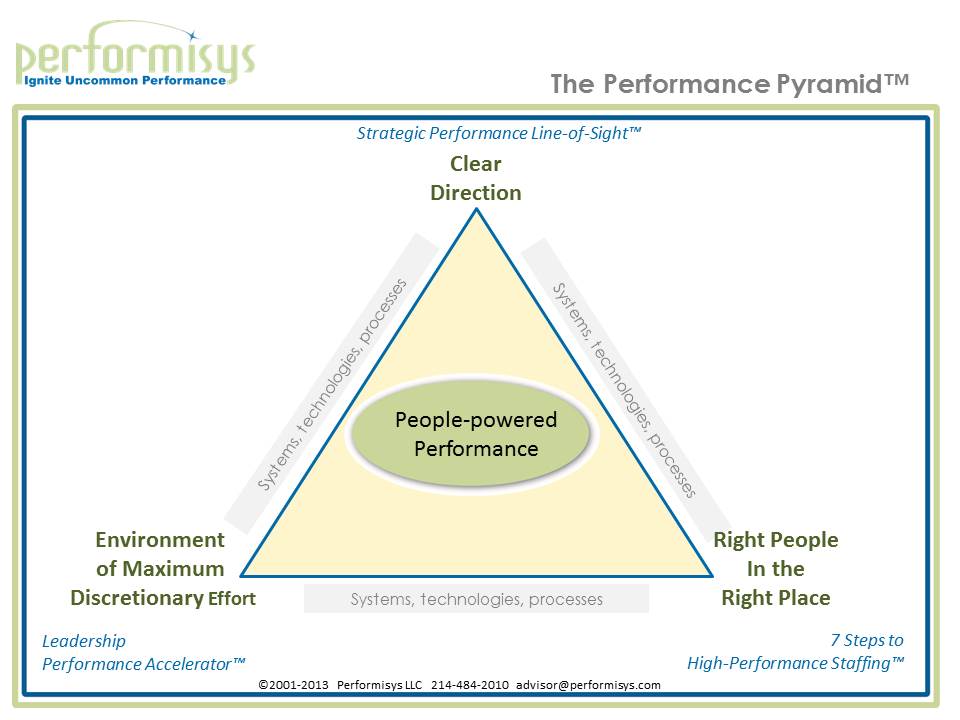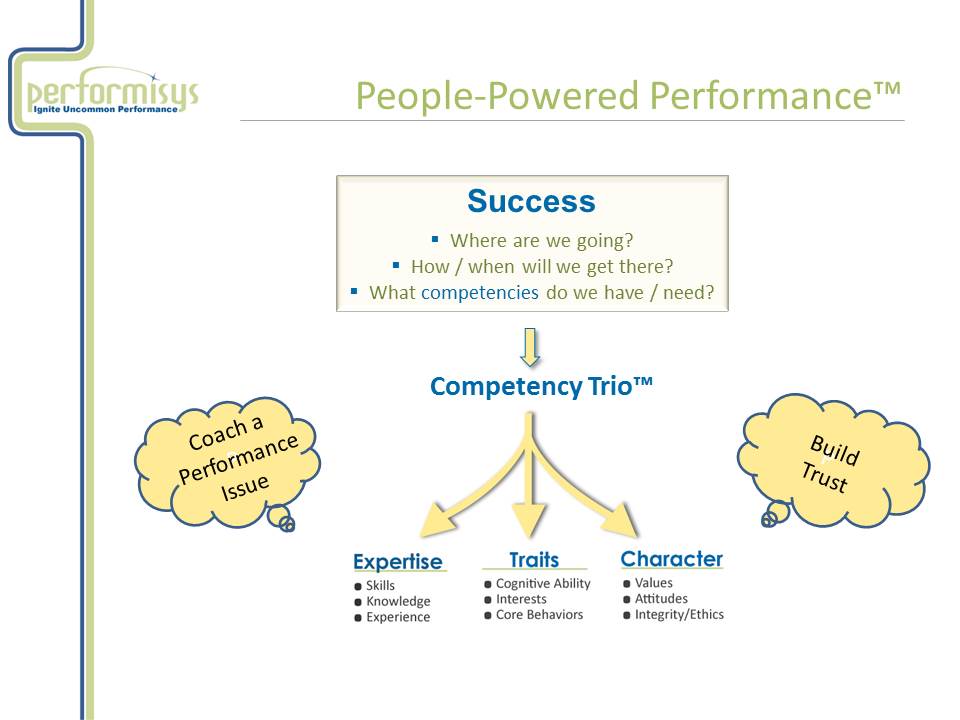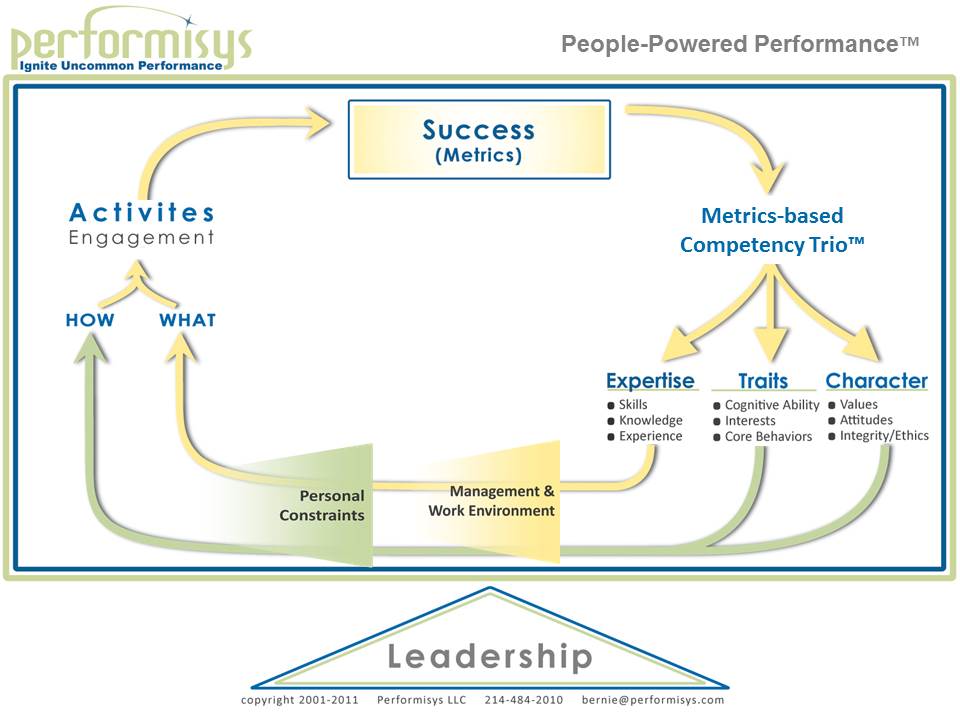The Performance Pyramid™ illustrates the three fundamental principles necessary to build a high performance organization. (Figure 1) At its core is the concept of People-powered Performance,™ a simple, yet comprehensive closed-loop model that begins by defining success and concludes by measuring progress toward it. Its purpose is to ensure we effectively execute strategies that are aligned to the organizational vision. Ultimately, it ensures that we have the right people in the right place doing the right thing at the right time with the application of maximum discretionary effort.

Misconceptions about competencies have caused poor decisions, poor staffing, poor coaching, poor leadership practices and poor business results. Despite many acclaimed approaches to performance improvement, the transfer of “best practices” has often met with failure. Different organizational cultures and desired images in the marketplace require different types of people – different competencies.
The impact of our model lies in the unique perspective it brings to staffing, coaching, team-engineering, trust- enabling and performance management. Once a clear direction is set and metrics established, we can next determine those competencies necessary for success. The goal, of course, is to transform competencies into action − the execution of the right activities.
Performisys has identified three distinct groups of competencies comprising The Competency Trio™ (Figure 2). Understanding and applying its premise can dramatically change an organization.

Figure 2.
This delineation of competencies into three major categories has huge implications when it comes to mentoring good performers and coaching poor performers It begs the question: is the poor performance caused by issues in Expertise, Traits or Character – or a combination?
Expertise covers skills, knowledge and experience. These issues are the most easily defined and identified, and are addressed simply by training. But while Expertise often takes the brunt of poor performance finger pointing, Traits and Character are the more usual reasons for failure.
Traits include cognitive abilities, core-behavioral tendencies that drive personality, and interests. Character is comprised of ethics, values and attitudes. The cumulative traits and character of an organization’s people define its culture. The detrimental impact of mismatches to the culture can sometimes be reduced through coaching and behavior modification but since Traits tend to be hard-wired, attempts to alter them can create stress. Burn-out, anyone?
As to Character – can it be changed? A plethora of inspiring stories of the reformed tell us “yes.” The question is: Is your workplace the place to conduct the reformation? Most often, it is not. The best time to ensure good character fit is at the point of hire.
Another significant implication of the Competency Trio™ is the insight it provides into understanding and creating high-trust environments. Expertise trust comes with the credibility of being the “go to” person for “how to” issues. But Expertise trust does not infer a right to Character trust − the issue with Enron leaders. While someone may have high trust as the subject matter expert, you might not let that person near your wallet. Traits trust is about being able to depend on a person to respond appropriately to the circumstances. Lack of initiative, over-aggressiveness, reluctance to address conflicts and/or failure to adapt to change are typically Traits based issues.
Figure 3 depicts the complete People-powered Performance™ model. The competencies grouped under Expertise largely determined what Activities will be performed, while those grouped under Traits & Character determine how they will be performed. Thus, an organization’s culture, values, and image is dependent on the impact Traits and Character have on strategy execution.

Figure 3.
As competencies are transformed into activities, they pass through two highly influential filters. The first is Management & Work Environment. When management styles and environment are empowering, competencies are leveraged and results multiplied. When they are ineffective, it doesn’t make much difference how talented the people are, they will not invoke the discretionary effort necessary to maximize results.
The second filter is Personal Constraints. These typically result from issues outside the workplace, such as marital or financial difficulties, that divert focus and inhibit performance regardless of competence.
The entire model rests on the fulcrum of Leadership. In the final analysis, it is always about the leadership. Effective, consistent leadership keeps the model in balance and producing results. Shift the Leadership fulcrum and the entire model tilts and results deteriorate.
Achieving uncommon success requires understanding The Competency Trio™ and the impact each element has within the organization. Applying this break-through thinking can dramatically improve staffing, coaching and performance. Only when the organization’s needs in the areas of Expertise, Traits and Character are identified and integrated can individuals team to drive an organization to its pinnacle.
For more information on our high-impact concepts and performance models check out the other “books” on this website or call me at 214-484-2010 to discuss your thoughts, questions and comments. I’d like to hear from you.
Bernie O’Donnell, Lead Consultant & CEO